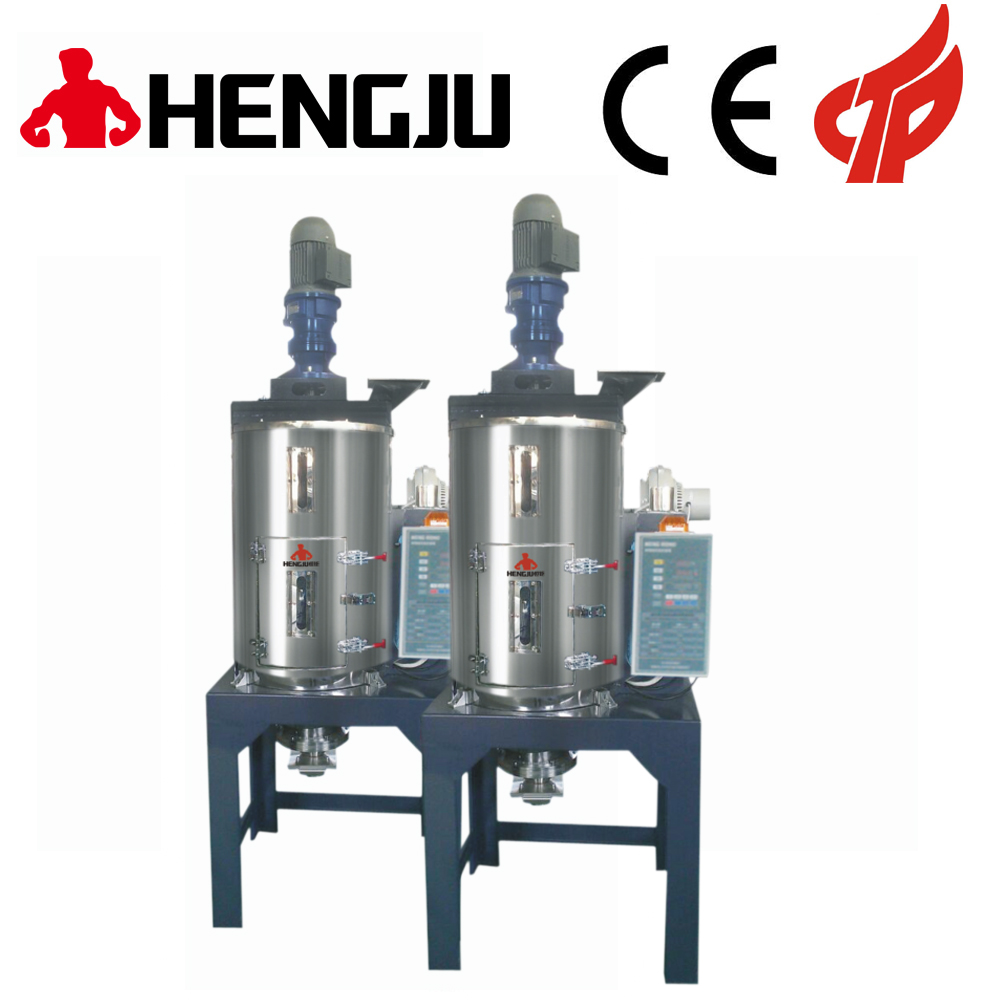Three-in-one dehumidification dryer:
In the drying process of the material, firstly, the moisture on the surface of the material is heated and vaporized and removed by the vacuum equipment. The moisture on the surface of the material is gradually reduced due to the vaporization, and a temperature difference is formed between the inside and the surface of the material. Under the action of the temperature difference, the internal moisture will continuously diffuse to the surface and vaporize after reaching the surface. In addition, in the vacuum drying process, there is a pressure difference at the same time, so the vaporized water molecules accelerate to move to the vacuum space.
In the vacuum drying process, people always want to speed up the drying speed and change the drying time. However, the following factors affect the drying speed:
1 The increase of the vacuum degree is more conducive to the vaporization of moisture at higher than the temperature, but too high a vacuum is disadvantageous to heat exchange and will affect the heating effect of the material. In order to increase the drying speed of materials, the vacuum degree should be considered comprehensively according to the characteristics of the materials.
2. Generally, the vacuum degree should not be less than 1×104Pa; the condition of the material to be dried (such as material shape, size, stacking method), the moisture content, density, viscosity and other properties of the material itself. But even if the pile is loose and thin, the internal moisture is easy to diffuse.
3. If the initial temperature of the material is increased, the vacuum filtration pre-treatment can reduce the moisture content of the material, etc., all of which can increase the vacuum drying speed.

The difference between rotary honeycomb and rotary molecular sieve:
The core component of the honeycomb wheel dehumidification dryer series, the honeycomb wheel is a continuously rotating honeycomb-shaped desuperheating wheel, the wheel is composed of a corrugated medium made of special ceramic fiber composite high-temperature materials; the wheel has a single height A partition made of silicone rubber with sealing performance separates the entire surface from each other by two, which absorbs moisture and is relatively stable. It can dehumidify air moisture and dew point up to -50℃. It is called the runner honeycomb.
The core component of the rotary molecular sieve desiccant dryer. The rotary molecular sieve is a synthetic desiccant product with intercalation for water molecules. The size of molecular sieve is controlled by different processing technology. It is a kind of aluminosilicate compound with cubic crystal lattice, which is mainly composed of open framework structure composed of silicon and aluminum connected by oxygen bridge. Dehumidifying the air moisture can only reach -30℃. It is called molecular sieve.
The dew point temperature refers to the temperature at which the contained moisture condenses into water droplets when the gas is cooled, and is a measure of the degree of dryness (relative) of the gas. The less moisture in the gas, the lower the dew point temperature. The dew point of the desiccant dryer must reach a dew point temperature of -40°C.
The above instructions suggest using a runner honeycomb.
Reason 1: The dew point of the air dehumidification of the runner honeycomb can easily reach -40℃, and the enhanced configuration can reach -50℃ for extra stability. Approximately 8 years, and can be used for 8-10 years under good maintenance.
Reason two: the air dehumidification dehumidification point of the runner molecular sieve. According to the information provided by market users. The dew point of the new rotor molecular sieve can only reach -32℃. After one year of use, the dew point will drop to -20℃. After one and a half years of use, the dew point will reach -10℃. The rotor molecular sieve can only be used at most. Two years long.
The structure of the wheeled honeycomb:
A honeycomb wheel structure of a plastic particle dehumidifier. One end of the honeycomb wheel is provided with an upper cover, and the other end is provided with a lower cover. The top surface of the upper cover is provided with a dehumidification air outlet and a regeneration exhaust port And a dehumidification air return port, the inner surface is provided with an exhaust area corresponding to the regeneration exhaust port, and a return area corresponding to the dehumidification air return hole, and an air outlet area corresponding to the dehumidification air outlet; the lower cover is provided with There is a regeneration zone, and a hot air inlet is established corresponding to the regeneration zone, the lower cover is provided with a cooling zone, and the cooling zone is placed at the air outlet, and the lower cover provides a dehumidification zone, and the dehumidification zone is placed at the inlet The tuyere and the honeycomb wheel are divided into a regeneration zone, a cooling zone and a drying zone according to the position in use. The regeneration zone refers to the exhaust zone corresponding to the upper cover and the regeneration zone of the lower cover. The cooling zone corresponds to the part between the reflux zone of the upper cover and the cooling zone of the lower cover; the drying zone corresponds to the air outlet zone of the upper cover and the lower cover The part between the dehumidification zone is characterized in that: a driving device is equipped to drive the honeycomb wheel to rotate. The driving device is composed of a motor and a gear set, and the gear set is equipped with a rotating shaft; the dehumidification of the upper cover The air outlet, the regeneration exhaust outlet and the dehumidification air return outlet are all equipped with interspaces, and in the exhaust area, the return area and the inner surface of the air outlet area, there is an insulation layer; and the regeneration of the lower cover There is a certain interval between the cooling zone, the cooling zone and the dehumidification zone, and in the regeneration zone, the inner surface of the cooling zone and the dehumidification zone is provided with a heat insulation layer, so that the arrangement between the air outlet zone and the return zone of the upper cover Between the return pipe.
Working principle of plastic dehumidifier
The core component of the honeycomb wheel dehumidifier series is a continuously rotating honeycomb-shaped desuperheating wheel, which is made of corrugated medium made of special composite heat-resistant materials; the wheel is made of silicone rubber with high sealing performance The fragments separate the entire surface from each other in two directions: 270 degrees of treatment thickness; 90 degrees of regeneration reduction settlement. When the targeted air that needs to be dehumidified enters the 270-degree-shaped processing area of the runner, the water vapor of the wet air is absorbed by the active silica gel of the runner and enters the 90-degree regeneration reduction decomposition. The dry air is processed and sent to the drying hopper by the fan. , There is an appropriate amount of hygroscopic substitute plastic material inside the hopper, and the dehumidified and dried air absorbs the internal water content of the plastic material and absorbs the increase of moisture absorption, so that the runner restores the moisture absorption ability and completes the regeneration process. Under the action of the drying fan, the dehumidified air is sent to the dehumidifier, and the dehumidified water gradually becomes more saturated. Driven by the speed control motor, it slowly transfers to the slow cooling zone, and the high temperature air blown in reversely after regeneration After the water adsorbed in the runner is desorbed, it enters the dehumidification area for dehumidification. The dehumidification and regeneration process happen at the same time, the air is continuously dried, the runner is continuously regenerated, and the cycle starts again, thus ensuring the continuous stability of the dehumidifier. The runner rotates 8-12 revolutions/hour, and the required power is very small. The air outlet of the dehumidifier The parameter conditions only depend on the parameters of the inlet air and the control of the regeneration energy. The working principle and advantages of the rotary dehumidifier ensure the continuous and stable dehumidification state of the dehumidifier.
Rotary honeycomb features
This design has a compact structure and can provide a huge size for full contact between the humid air and the hygroscopic medium. Thereby greatly improving the dehumidification efficiency of the dehumidifier. How to use plastic dehumidifier The plastic dehumidifier is an automatic closed dehumidification and drying equipment that is matched with a hopper dryer and an automatic suction machine to dehumidify and dry plastic raw materials with hygroscopic additives. The traditional method of using heat instead of plastic raw materials for drying. Through the precise pursuit of the market, engineering plastics such as PA, PC, PBT, PET and other hygroscopic additives cannot meet market demand by using traditional plastics. And "Shenzhen Jiujing Machinery Manufacturing Factory" first developed one. The dehumidification and drying process of the raw materials is carried out in a fully enclosed state with a low dew point of -40°C, and the dehumidified plastic raw materials will not contact the outside air. In order to meet the most ideal needs of the market, it is the first and most plastic dehumidifier in the high-precision plastic industry. The air passages of the plastic dehumidification dryer adopt a closed circulation system and filter at the same time, so it is not affected by the external climate and can prevent dust from being inside the factory Cause pollution and improve the working environment.
The determinants of a good drying efficiency are: drying temperature (drying temperature), drying time (residence time), air volume (air flow), and dew point (dew point). These four factors are linked together, and any change in conditions will affect Drying effect.
Drying temperature refers to the temperature of the air entering the drying barrel. Due to its physical properties, such as molecular structure, specific gravity, specific heat, selectivity and other factors, the drying temperature must be limited to a certain degree. When the temperature is too high, Part of the additives are volatile or agglomerated. If they are too low, some crystalline raw materials cannot reach the required drying conditions, such as: PC/120℃, ABS/80~95℃. Drying time refers to the pre-drying time of raw materials before molding. Too long drying time will cause raw materials to deteriorate or agglomerate or waste energy. Too short drying time will cause waste. For example: PC / 3-4 hours, ABS / 3-4 hours. The air volume is the only medium that takes away the moisture in the raw materials, and the air volume will affect the dehumidification effect. Too much air volume will cause the return air temperature to be too high, causing overheating (overheating) and affecting the stability of the dew point. If the air volume is too small, the moisture in the raw materials cannot be completely taken away. The air volume also represents the dehumidification capacity of the desiccant dryer. Dew point temperature refers to the temperature at which the contained moisture condenses into water droplets when the gas is cooled, and is a unit for measuring the degree of dryness (dispersion) of the gas. The less moisture in the gas, the lower the dew point temperature. The dew point of a good desiccant dryer must reach a dew point temperature of -40℃
|
 +8613669807274
+8613669807274
 +8613669807274
+8613669807274 wto-btb@wto-btb.com
wto-btb@wto-btb.com Tel: +8613669807274
Tel: +8613669807274 SMS: +8613669807274
SMS: +8613669807274